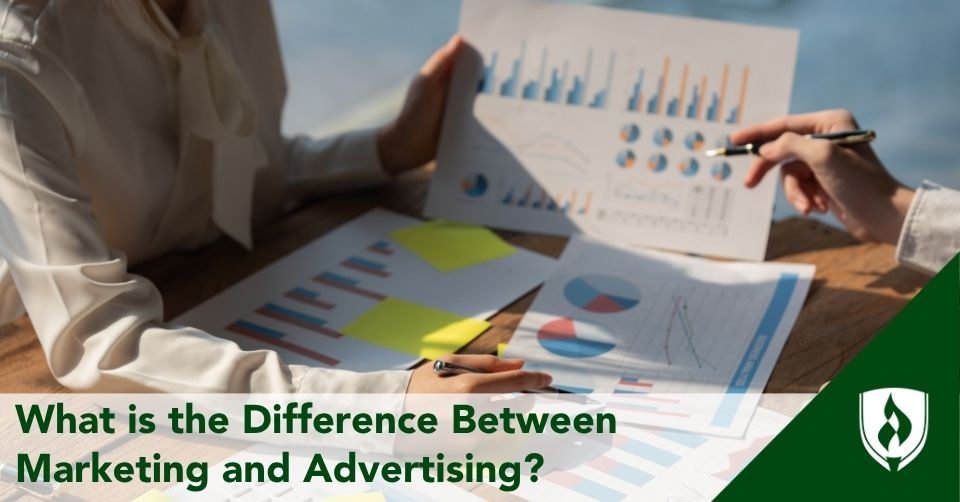What Is the Difference Between Marketing and Advertising?
11/06/2025

For anyone exploring business, communications, or digital media, understanding what the difference is between marketing and advertising can clarify how organizations communicate with audiences and make strategic decisions. While the terms are often used interchangeably, they serve distinct purposes.
Marketing builds1 brand awareness and offers perceived value, while advertising promotes products or services to engage a target audience. Although advertising is a component1 of marketing, the two work together to shape communication strategies, allocate resources, and align goals.
Considering the differences between marketing and advertising helps readers evaluate how a strategy that integrates both disciplines can guide engagement, strengthen brand recognition, and support consistent messaging across multiple channels.
Understanding Marketing
Marketing refers2 to a coordinated set of activities organizations use to understand, anticipate, and meet audience needs, including market research, product development, branding, and communication planning.
Key components of marketing include:1
- Market research analyzes consumer behavior and define the target audience.
- Content marketing, including blogs, videos, and social media posts, to inform and engage audiences.
- Social media marketing to participate in conversations and observe feedback on platforms such as Facebook® and Instagram®, TikTok® and X®.
- Search engine optimization (SEO) and broader digital marketing initiatives may enhance visibility and connect audiences across platforms.
- Relationship marketing to cultivate loyalty and foster ongoing engagement.
- Global marketing to consider campaigns that have the potential to reach audiences across regions.
- Brand management to ensure consistent identity, visuals, and tone.
- Product development, informed by market research, to align offerings with audience needs.
Developing a marketing plan requires both analysis and creativity. Tools2 such as marketing automation platforms help track interactions, schedule social posts, and evaluate engagement. These tools support a personalized strategy that aligns marketing and advertising, ensuring messages are targeted and coherent.
Modern marketing strategies also reflect a company’s orientation,2 the guiding philosophy behind its operations. Some organizations prioritize product innovation or sales, while others may emphasize customer relationships and brand experience. Aligning strategies with these principles may help resources and communications be more direct intentional. Evaluating2 the marketing mix, including the four Cs of client, cost, convenience, and communication, may help organizations make informed choices about messaging, channels, and campaign execution.
What Is Advertising?
While marketing encompasses broad strategic planning, advertising focuses2 on paid efforts designed to reach a target audience and generate measurable responses. Advertising is a paid form2 of promotion, that includes paid ads, social media ads, native ads, video marketing, print ads, retail advertising, and mobile advertising. Unlike marketing, advertising establishes a one-way communication channel in which organizations have full control over how messages are presented.
Advertising goals may include2 informing potential audiences about a product or service, maintaining brand visibility, or generating interest. Businesses often evaluate ad spend carefully, selecting the relevant advertising channels such as social media channels, search engines, websites, or traditional advertising like TV, radio, and print.
Ad campaigns are driven2 by market research and insights into consumer behavior. Aligning advertising with marketing ensures that campaigns remain relevant and resonate with target audiences.
Common Types of Marketing and Advertising
In practice, marketing and advertising share several overlapping tools and platforms. A strong marketing foundation has the potential to enhance advertising performance by ensuring that every campaign connects with its intended audience.
Marketing strategies may include:2
- Digital marketing, including websites, blogs, email marketing, and mobile advertising.
- Social media marketing, including influencer marketing and content marketing tailored to specific platforms.
- Search engine optimization (SEO) to increase visibility in search engines.
- Global marketing, to coordinate cross-market campaigns while maintaining consistent messaging.
- Brand management and relationship marketing to foster engagement and strengthen brand recognition.
Advertising strategies may include:2
- Paid ads, including Google® Ads, social media ads, and native advertising.
- Video marketing on platforms like YouTube® or in-stream placements.
- Retail advertising with in-store displays and promotions.
- Print ads in newspapers, magazines, and other traditional media.
- Mobile advertising via apps or banners.
- Pay-per-click (PPC) advertising, where payment depends on user engagement.
Recognizing how these tools overlap may help businesses integrate their marketing and advertising efforts for consistency across campaigns.
The Role of Digital Marketing
Digital marketing plays a central role in connecting marketing and advertising strategies. It bridges long-term audience engagement with short-term promotional efforts.
Strategies may include:3
- Social media marketing, using both social media posts and social media ads to reach targeted audiences.
- Search engine optimization (SEO) and Google® Ads to increase discoverability.
- Email marketing for direct, personalized outreach.
- Video marketing and native advertising to engage audiences through interactive content.
- Marketing automation platforms to track performance and optimize advertising efforts.
Digital marketing demonstrates how marketing and advertising work together: Marketing provides strategic context, while advertising may ensure visibility and measurable engagement.
Integrating Marketing and Advertising
A personalized strategy that integrates marketing and advertising may allow businesses to coordinate long-term goals with short-term campaigns.
Some considerations to keep in mind may include:1
- Marketing strategies that define audiences, guide messaging, and plan content distribution.
- Advertising strategies that select channels, deploy ad campaigns, and monitor performance.
- Ad placement decisions across social media, search engines, or traditional platforms.
By integrating marketing and advertising, organizations create unified messaging across paid, owned, and earned media with a goal to strengthen both audience trust and recognition.
Key Differences Between Marketing and Advertising
The distinctions between marketing and advertising involve1 scope, approach, and timing:
- Marketing builds brand awareness and establishes strategies to meet audience needs over time.
- Advertising focuses on promoting products or services to generate immediate responses through paid channels.
- Marketing involves strategy, market research, and creative planning, while advertising executes targeted campaigns across specific media.
Understanding marketing vs advertising may allow students and professionals to consider how these fields complement each other. Marketing shapes the message, while advertising delivers it effectively.
Why Understanding Marketing and Advertising Matters
Together, marketing and advertising form a cohesive communication framework. Marketing2 defines purpose and positioning, while advertising translates that strategy into action through paid promotions and measurable engagement. Developing an integrated marketing plan helps ensures that every campaign works toward shared objectives and consistent brand identity.
Understanding marketing vs advertising provides a framework for analyzing business strategies, planning campaigns, and making informed decisions about which tactics best suit specific objectives and audiences.
X® is a registered trademark of X Corp.
Facebook® is a registered trademark of Meta Platforms, Inc.
Instagram® is a registered trademark of Instagram, LLC.
LinkedIn® is a registered trademark of LinkedIn Corporation.
YouTube® is a registered trademark of GOOGLE LLC.
Google® Ads is a registered trademark of GOOGLE LLC.
1American Marketing Association, “Marketing vs. Advertising,” https://www.ama.org/marketing-vs-advertising/ (accessed October 7, 2025).
2American Marketing Association, “The Definition of Marketing,” https://www.ama.org/the-definition-of-marketing-what-is-marketing/ (accessed October 7, 2025).
3American Marketing Association, “What Is Digital Marketing?” https://www.ama.org/what-is-digital-marketing/ (accessed October 7, 2025).



